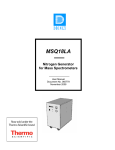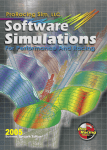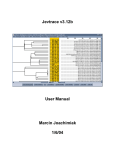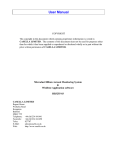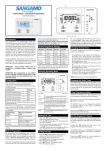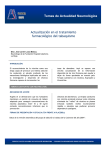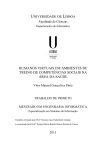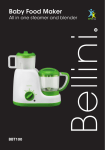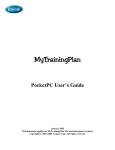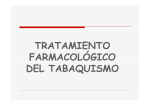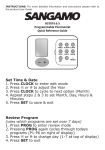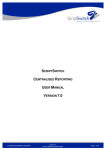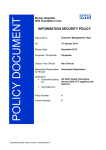Download Guidance Notes for Service Delivery Smokefree Pharmacy Services
Transcript
Guidance Notes for Service Delivery Smokefree Pharmacy Services West House Gartnavel Hospitals Glasgow G12 0XH 0141 201 4945 Issued October 2008 Revised: August 2014 Index Introduction Health Efficiency Access and Treatment (HEAT) Targets Aim of the Smokefree Pharmacy Service Professional Objectives Service Support Smokefree Training for Pharmacists & Assistants Client Journey through the Pharamcy Service with NRT Dual NRT Pharmacy Smokefree Enhanced Service Smokefree Young People Service (12-18 years) Varenicline® (Champix) Client Journey through the Pharmacy Service with Varenicline® (Champix) Housebound Clients Carbon Monoxide (CO) Monitoring Product Information Dosage Regiment Per Product Cigarette Equivalents for Tobacco Users Contact Details Smoking Cessation Contacts in Greater Glasgow & Clyde CHCPs Client Journey Pharmacy Role – Weeks 0 – 10/12 Prescribing NRT Guidance Appendix 1: Smoking Cessation and Pharmacy Care Record (PCR) August 2014 1 Page 2 Page 2 Page 3 Page 3 Page 3 Page 3 Page 4 Page 8 Page 8 Page 8 Page 9 Page 10 Page 14 Page 14 Page 16 Page 17 Page 19 Page 20 Page 21 Page 22 Page 23 Page 25 INTRODUCTION Adult smoking rates in Scotland have remained consistently higher than in England and Wales. Throughout the 1970's and 1980's, the number of people smoking cigarettes fell sharply but this decline levelled out during the 1990s. Smoking rates among young teenagers are also of concern for health professionals and policy makers and national targets have been set relating to these. See www.ashscotland.org.uk for further details. A flavour of previous targets can be found at www.scotland.gov.uk Smoking is the United Kingdom’s single greatest cause of preventable illness and early death. Currently about 13 million adults in the country smoke with more than 120,000 people in the United Kingdom dying from smoking related diseases annually. In addition, passive smoking kills hundreds every year while the totality of smoking attributable diseases costs the NHS up to £1.7 billion each year. The Tobacco Strategy sets out a three year plan of action with a budget of £100 million allocated to support its implementation. Three groups in particular are targeted- under 16s who are smokers, adults living in disadvantaged communities and pregnant women. Community pharmacists are in the ideal position to help all of these groups. Success will be measured by performance against the allocated targets set for Scotland. On average, each community pharmacy in Greater Glasgow and Clyde serves the needs of 1,500 –2,000 smokers. Community pharmacists and counter staff who have been trained as smoking cessation pharmacy advisers are ideally placed to directly supply Nicotine Replacement Therapy (NRT) to patients within the product licenses. This has the support of the Local Medical Committee as this model cuts down the workload of GPs and also improves patient access to NRT. In addition, these pharmacists & staff can offer support & advice to patients prescribed varenicline. It is however anticipated that annually, at least 85% of smokers motivated to stop, will do so through the Pharmacy Smokefree Service. Health Efficiency Access and Treatment (HEAT) Targets The HEAT targets are a core set of Ministerial objectives, targets and measures for the NHS.A HEAT target has been set in relation to smoking cessation. The 2014-15 target is for NHS Scotland to deliver at least 12,000 successful quits at 12 weeks post quit ending March 2015. From these quits 40% must be from the most deprived datazones (60% in island Health Boards). As Health Boards are accountable for delivery of the targets set, a huge amount of importance is focused on Pharmacy Smokefree Services. Further information on HEAT targets can be found at www.scotland.gov.uk August 2014 2 Aim of the Smokefree Pharmacy Service To develop a network of accredited community pharmacies throughout NHS Greater Glasgow and Clyde offering an easily accessible, cost-effective smoking cessation service by means of support, supply and dispensing of NRT. Varenicline can also be supplied in accordance with a Patient Group Directive (PGD) . Professional Objectives • To provide structured, evidence based support to patients supplied NRT or varenicline on a weekly basis for a maximum of 12 weeks • To promote compliance and maximise effectiveness of NRT and varenicline • To involve both the pharmacist and the counter assistants in the support • To collect appropriate data • Which product is recommended? The GGC Formulary product of choice is currently NiQuitin Clear®, a 24 hour patch available in three strengths. Other products from the NiQuitin® range can be prescribed as second line products in Glasgow and Clyde. See page 16 for further guidance on NRT products. NICE guidance does not differentiate between the efficacy of 16 hour and 24 hour patches. (www.nice.org.uk/pdf/niceNRT39GUIDANCE.pdf). • If a patient has tried and failed to quit using NRT (as per GGC criteria), varenicline can be considered as an alternative product. Service Support • The Smokefree Service is supported by the Public Health Pharmacy Facilitator Network & outside agencies who will undertake to visit/mail each of the participating pharmacies, to address any problems or difficulties and ensure supplies of appropriate materials • A window sticker is provided showing that the pharmacy is accredited to take part in the service together with posters, leaflets & a Carbon Monoxide monitor • The pharmacist orders NRT from their wholesaler in the usual way SMOKEFREE TRAINING FOR PHARMACISTS & ASSISTANTS Smoking cessation training is compulsory for every staff member involved in the service. A minimum of one pharmacist must attend the NHS GG&C Pharmacy Smokefree Services training programme to become an accredited pharmacy in terms of the Service. Assistants can also offer this service by attending the training day. We particularly encourage highlighting the training opportunities to regular locum pharmacists. The training programme incorporates the NES Smoking Cessation distance learning pack. SERVICE OVERVIEW This specialised service is based on the brief intervention model. Research has shown that the more support offered to clients the better. By spending 10 minutes with clients and helping them through their quit attempt, their chances of success increase by more than 230% compared with no intervention. It is therefore vital that a minimum of 10 minutes is spent with clients at each visit. Clients can either be approached directly, sign-posted by a healthcare professional or opportunistically asked about their smoking habits or the pharmacist/assistant August 2014 3 can wait until approached by the customer. The option of joining a Smokfree Community Group as an alternative to the pharmacy service, should be discussed with the client. If a client wishes to join a local smoking cessation group, provide the client with the phone number to register. a) Client Journey through the Pharmacy Service with NRT • Pre-quit attempt: when the patient is initially identified. Assess the patient’s current smoking status and previous quit attempts. Obtain consent to follow-up the patient. This includes times when the patient fails to attend the pre-arranged appointment. If patient does not consent, they are ineligible to join the Service. Record contact details for the patient including telephone numbers. Check if the patient is motivated to stop smoking. Ascertain if group sessions are preferable – if so refer. Discuss the advantages and disadvantages of stopping smoking. Provide information on the NRT options, in line with GGC Formulary guidance, for the patient to consider and issue. Discuss the Want to Stop Smoking? leaflet. Record the patient’s details and motivation to quit in the smoking cessation support tool within PCR. Discuss setting a formal quit date around 7 days after initial visit if the patient is deemed ready to quit. Do not set the quit date in the smoking cessation support tool at this stage, Arrange an appointment for the patient to return for NRT and further support, as near as possible to the quit date. Provide the How to Stop and Stay Stopped booklet and encourage the patient to complete the relevant sections. Show these to the patient. Offer the patient the Smokefree Services diary. If accepted, help them complete the mission statement and show them how to use the diary. Introduce the patient to the member of staff who will help support them through their journey and record their name on the support card. DO NOT routinely provide NRT at this visit. • Return appointment - Quit Date: when the patient attends the return appointment: Determine the patient’s initial smoking status using a Carbon Monoxide (CO) monitor. Discuss pages from the relevant sections of the ‘How to Stop Smoking and Stay Stopped’ booklet to ensure the patient wants to stop smoking. August 2014 4 Identify the NRT product(s) most suitable, in line with GGC Formulary and Service guidance. Patients who have tried and failed before and are smoking on average 20 cigarettes or more per day, are eligible for dual NRT for the first four weeks. Enhanced patients for 12 weeks. Ensure that the patient has been fully assessed for the use of NRT in relation to medical conditions, medicines, and pregnancy/breastfeeding. Confirm the quit date for within the next few days. Complete a CPUS form for each supply of NRT made. Ensure that the patient’s CHI number is recorded on the form for payment. Record any additional patient data in PCR. Record the results of the CO reading in PCR and also on the patient’s CO Monitoring Card. Electronically submit the MDS data detailing the quit date from PCR immediately after the appointment. This will trigger the first payment, £30. Explain to the patient the use of the recording of their data on the national database, i.e. that by signing the CPUS form they are consenting for data sharing with relevant NHS personnel and that they may be contacted for follow-up at a later date. Invite the patient to attend the pharmacy to receive ongoing support and further supplies of NRT for up to a 12-week time period. Explain to the patient that if they do not attend any arranged appointments they will be contacted to reschedule. • Subsequent weeks prior to 4-week post-quit date follow-up appointment: Ask how the patient “got on” during the past week. Use the diary to help discussions Determine the patient’s smoking status at each supply interval using the CO monitor. Record on the CO Monitoring card. Record the results of the CO reading in the smoking cessation support tool within PCR. Assess compliance with and suitability of product. Reinforce the correct use of NRT – check strength and formulation are still appropriate Give encouragement to continue in the quit attempt Arrange follow up appointments. Follow-up patients who do not present as anticipated e.g. through a proactive telephone call or text message. At least three attempts should be made to follow-up with patients who have not presented according to local NHS Board procedures. Dates and times of attempts to contact should be recorded within the smoking cessation support tool. If no response after two missed visits and three attempts of contact then inform the office on 0141-201-4945 August 2014 5 If the patient is deemed to have ended their quit attempt, then this should be recorded within PCR and the MDS submitted electronically. • Four-week post quit-date follow-up appointment: Determine the patient’s smoking status using the CO monitor to provide feedback. Record the results of the CO reading in the smoking cessation support tool within PCR. Electronically submit the MDS data from PCR immediately after the four-week post-quit date appointment but no later than six-week post-quit date. This triggers the second payment of £15. If the patient is a non-smoker, issue the Four Week Bronze Certificate Patients who do not attend the arranged appointment should be contacted to reschedule. If no response after three attempts of contact then record within PCR and submit it electronically. If at the 4-week post-quit date follow-up the patient reports having smoked in the last two weeks then the pharmacist should record accordingly. A new quit attempt can be started at any point thereafter as long as the new quit attempt is undertaken at the same community pharmacy. However, it is best to allow time to elapse for patients to renew motivation, re-prepare, and have a better chance at a subsequent quit attempt. • Subsequent weeks prior to the 12-week post-quit date follow-up appointment: Ask how the patient “got on” during the past week and assess compliance with and ongoing suitability of product. Use the diary as a discussion point. Determine the patient’s smoking status at each supply interval using the CO monitor to provide feedback. Record on the CO card. Record the results of the CO reading in the smoking cessation support tool within PCR. Make subsequent supplies at each defined supply interval. Re-assess NRT strength with the aim of discontinuing by the end of the 12-week period. At eight weeks post quit date, issue the silver certificate. Complete a CPUS form for the appropriate supply quantities of NRT. Do not endorse with a total quantity to be dispensed weekly. August 2014 6 Continue to give encouragement and advice (both written and verbal) as required by the patient and according to national and local guidance in order to support the quit attempt. Three attempts should be made to follow-up with patients who have not presented according to local NHS Board procedures. Dates and times of attempts to contact should be recorded within the smoking cessation support tool. If no response after two missed visits and three attempts of contact then record as lost to follow up in the MDS within PCR and submit it electronically. Details of patients who are lost to follow-up should be relayed to the Pharmacy Office (0141-201-4945). • 12-week post-quit date follow-up appointment: Determine the patient’s smoking status using the CO monitor to provide feedback. (A reading of less than 10ppm verifies the client as a non-smoker. Record the results of the CO reading in the smoking cessation support tool within PCR. Congratulate the patient and encourage them to stay quit. Issue the gold certificate. Electronically submit the MDS data from PCR immediately after the appointment but no later than 14 weeks after the quit date. This triggers the third payment of £20. Patients who do not attend the arranged appointment should be contacted to reschedule. If no response after three attempts of contact then record as lost to follow up in the smoking cessation support tool within PCR and submit it electronically. Details of patients who are lost to follow-up should be relayed to the Pharmacy Office (0141-201-4945). If at the appointment the patient reports having more than five cigarettes since the 4 week follow up, they are deemed a smoker. Any further cessation support to the patient should be defined as a new quit attempt. Under these circumstances a new quit attempt can be started at any point thereafter based on the professional judgement of the pharmacist. Beyond Week 12 Where a patient requires advice beyond the 12-week period then they should be advised that they can also seek support from local specialist smoking cessation services and the national telephone support line Smokeline on 0800 848 484. The service is open every day from 8am – 10pm and is supported by a website which offers interactive web chat with trained support staff http://www.canstopsmoking.com 1. A CPUS form, including the client’s CHI number must be completed each week for each client 2. If a GP10 is received for NRT, please advise either the GP that in NHS GG&C, NRT should be prescribed solely on a CPUS, or telephone the office (201-4945) August 2014 7 3. CO levels should be monitored weekly but mandatory at 4 and 12 weeks post quit date 4. Cessation strategies are discussed and personalised advice and support provided by pharmacy staff. Encourage the client to use the Smokeline freephone number 0800 84 84 84 for additional support and advice 5. The NRT will be dispensed weekly unless the client has a legitimate reason why this should not be so (for a maximum of 12 continuous weeks) together with support from a trained member of staff. Dual NRT From June 2010, patients who have accessed either the pharmacy or group service, failed to stop smoking and match the inclusion criteria listed below, have been offered the opportunity to use dual NRT therapy for the first four weeks. Research shows that when combination NRT together with behavioral support is offered on an individual basis, there is a 20% increase in four week quit rates from 37% to 50% and when in combination with group support, from 50% to 71%. (NHS stop smoking services can help to improve quit rates. Bauld L. Guidelines in Practice, December 2009, Vol 12 (12). Criteria for dual NRT (all the following criteria must be matched) • Client smokes 20 or more cigarettes per day • Client must have previously tried NRT and attended an NHS Greater Glasgow and Clyde (NHSGGC) smoking cessation service (pharmacy, group or acute). • Client is neither pregnant nor breastfeeding • Client is not allergic to NRT patch. • Start on NiQuitin® 21mg patch with the option of a second product if the patient has tried and failed with 21mg patch previously. Otherwise, review at week 2. If still smoking, offer additional short acting NRT (minis lozenge, gum, lozenge or strips) product. (If patient very addicted to smoking, two products may be considered at week one). • Weeks 2, 3 & 4. Review use of second product and supply again if necessary. After week 4, advise client to purchase second product if required. b). Pharmacy Smokefree Enhanced Service (Enhanced Service) A number of pharmacies in the more deprived areas of Greater Glasgow and Clyde are delivering the Enhanced Service. This provides the option of dual NRT for the duration of the service. Pharmacies located in these areas may be eligible to take part in the service. Separate training and operating procedures apply here. Further information is available by contacting Pharmacy Smokefree Service office on 0141-201-4945. c). Smokefree Young People Service (12 – 18yrs) Under revised guidance, all forms of NRT can now be used by smokers aged 12 and over, although there is limited evidence around the use of NRT in young people aged 12 to 17. If the pharmacist considers it appropriate i.e. the young person is a regular smoker and is motivated to stop, they can be signed up to a Smokefree pharmacy in the usual manner. Consequently we recommend that this group August 2014 8 should not use NRT unless they have access to a support network to ensure that nicotine dependency and motivation to stop has been assessed. Across NHS Greater Glasgow and Clyde there is a youth stop smoking service for young people aged 18 and under. The stop smoking advisor will assess their motivation to quit and nicotine dependency and if suitable complete a NRT request form for the young person to bring to the Smokefree Pharmacy service. If you think a young person would benefit from the Youth stop smoking service please provide the client with the Smokeline number 0800 84 84 84 or go to www.w-west.org.uk Where a young person is not accessing the Smokefree Youth Stop Smoking Service the pharmacist should, if possible involve the parent/carer in the quit attempt by asking them to accompany the youngster to the pharmacy on a weekly basis, as this will aid success. However, consent of a parent or legal guardian is required if the patient is under 13 years of age. Pharmacists should follow the advice of the Caldicott Guardian in their local health board on establishing and recording consent for patients without capacity. d). Varenicline Varenicline is a prescription only medicine (POM) and so can only be prescribed by a GP/Nurse prescriber, trained Independent Pharmacy Prescriber and pharmacists who have completed relevant training and signed the Patient Group Direction (PGD) for varenicline. It is a selective nicotine acetylcholine partial agonist that binds to a specific nicotinic receptor subtype. This receptor modulates the release of dopamine in response to nicotine, reinforcing its rewarding properties. Varenicline releases less dopamine and releases it more slowly than nicotine, theoretically reducing the craving and withdrawal symptoms of smoking cessation without producing its own dependence. The most common side-effect associated with varenicline is nausea. Delaying the morning dose of the tablet until the client has had something to eat does help negate this sideeffect. Dosing information Adult, over 18 years. Start 1-2 weeks before the target stop date. 0.5mg daily on days 1-3, 0.5mg twice daily on days 4-7 and 1mg twice daily thereafter for 11 weeks. A support programme to help clients quit, using varenicline, can be found at www.myliferewards.co.uk or by ‘phoning 0800 3457905 for a paper copy of the support pack should the client prefer. Support should be offered from either the Smokefree adviser or pharmacy. The summary of the referral guidance sent to GPs and pharmacists that should be offered when varenicline is prescribed is detailed below. If any adverse effects are experienced, these must be recorded using the yellow card reporting system. Yellow cards and guidance on their use are available at the back of the BNF or online at http://yellowcard.mhra.gov.uk/ August 2014 9 Client Journey through the Pharmacy Service with Varenicline (Champix®) • Pre-quit attempt: when the patient is initially identified. Assess the patient’s current smoking status and previous quit attempts. Obtain consent to follow-up the patient. This includes times when the patient fails to attend the pre-arranged appointment. If patient does not consent, they are ineligible to join the Service. Record contact details for the patient including telephone numbers. Check if the patient is motivated to stop smoking. Ascertain if group sessions are preferable – if so refer. Discuss the advantages and disadvantages of stopping smoking. Provide information on varenicline. Discuss the Want to Stop Smoking? leaflet. Record the patient’s details and motivation to quit in the smoking cessation support tool within PCR. Discuss setting a formal quit date around 7 days after initial visit if the patient is deemed ready to quit. Do not set the quit date in the smoking cessation support tool at this stage, Arrange an appointment for the patient to return for varenicline Starter Pack and further support, as near as possible to the quit date. Provide the How to Stop and Stay Stopped booklet and encourage the patient to complete the relevant sections. Show these to the patient. Offer the patient the Smokefree Services diary. If accepted, help them complete the mission statement and show them how to use the diary. Introduce the patient to the member of staff who will help support them through their journey and record their name on the support card. DO NOT routinely provide varenicline at this visit. • Return appointment - Quit Date: when the patient attends the return appointment: Determine the patient’s initial smoking status using a Carbon Monoxide (CO) monitor. Discuss pages from the relevant sections of the ‘How to Stop Smoking and Stay Stopped’ booklet to ensure the patient wants to stop smoking. Advise the patient’s GP that their patient will be starting a “stop smoking” attempt using varenicline. Confirm the quit date for within the next few days. Complete a CPUS form for the titration pack. Patients CHI number must be on the form for payment August 2014 10 Record any additional patient data in PCR. Record the results of the CO reading in PCR and also on the patient’s CO Monitoring Card. Electronically submit the MDS data detailing the quit date from PCR immediately after the appointment. This will trigger the first payment, £30. Explain to the patient the use of the recording of their data on the national database, i.e. that by signing the CPUS form they are consenting for data sharing with relevant NHS personnel and that they may be contacted for follow-up at a later date. Invite the patient to attend the pharmacy to receive ongoing support and further supplies of NRT for up to a 12-week time period. Explain to the patient that if they do not attend any arranged appointments they will be contacted to reschedule. • Subsequent weeks prior to 4-week post-quit date follow-up appointment: Ask how the patient “got on” during the past week. Use the diary to help discussions. Assess compliance with and suitability of product. Reinforce the correct use of varenicline and discuss any concerns about side effects. If patient is experiencing side effects consider reducing the dose to 0.5mg twice daily temporarily or permanently or alternatively stopping varenicline and commencing on a course of NRT. Determine the patient’s smoking status at each supply interval using the CO monitor. Record on the CO Monitoring card. Record the results of the CO reading in the smoking cessation support tool within PCR. Make subsequent supplies of varenicline (pharmacist only) when necessary using the 28-day pack. Arrange follow up appointments at weekly intervals. Give encouragement to continue in the quit attempt. Follow-up patients who do not present as anticipated e.g. through a proactive telephone call or text message. At least three attempts should be made to followup with patients who have not presented according to local NHS Board procedures. Dates and times of attempts to contact should be recorded within the smoking cessation support tool. If no response after two missed visits and three attempts of contact then inform the office on 0141-201-4945. August 2014 11 If the patient is deemed to have ended their quit attempt, then this should be recorded within PCR and the MDS submitted electronically. • Four-week post quit-date follow-up appointment: Determine the patient’s smoking status using the CO monitor to provide feedback. Record the results of the CO reading in the smoking cessation support tool within PCR. Electronically submit the MDS data from PCR immediately after the four-week post-quit date appointment but no later than six-week post-quit date. This will trigger the second payment of £15. If the patient is a non-smoker, issue the Four Week Bronze Certificate Patients who do not attend the arranged appointment should be contacted to reschedule. If no response after three attempts of contact then record within PCR and submit it electronically. If at the 4-week post-quit date follow-up the patient reports having smoked in the last two weeks then the pharmacist should record accordingly. A new quit attempt can be started at any point thereafter as long as the new quit attempt is undertaken at the same community pharmacy. However, it is best to allow time to elapse for patients to renew motivation, re-prepare, and have a better chance at a subsequent quit attempt. • Subsequent weeks prior to the 12-week post-quit date follow-up appointment: Ask how the patient “got on” during the past week and assess compliance with and ongoing suitability of product. Use the diary as a discussion point. Determine the patient’s smoking status at each supply interval using the CO monitor to provide feedback. Record on the CO card. Record the results of the CO reading in the smoking cessation support tool within PCR. Make subsequent supplies of varenicline when necessary at two-weekly intervals. Complete a CPUS form for the varenicline including CHI number. At eight weeks post quit date, issue the silver certificate. Complete a CPUS form for the appropriate supply quantities. Do not endorse with a total quantity to be dispensed weekly. August 2014 12 Continue to give encouragement and advice (both written and verbal) as required by the patient and according to national and local guidance in order to support the quit attempt. Three attempts should be made to follow-up with patients who have not presented according to local NHS Board procedures. Dates and times of attempts to contact should be recorded within the smoking cessation support tool. If no response after two missed visits and three attempts of contact then record as lost to follow up in the MDS within PCR and submit it electronically. Details of patients who are lost to follow-up should be relayed to the Pharmacy Office (0141-201-4945). • 12-week post-quit date follow-up appointment: Determine the patient’s smoking status using the CO monitor to provide feedback. (A reading of less than 10ppm verifies the client as a non-smoker. Record the results of the CO reading in the smoking cessation support tool within PCR. Congratulate the patient and encourage them to stay quit. Issue the gold certificate. Electronically submit the MDS data from PCR immediately after the appointment but no later than 14 weeks after the quit date. This will trigger the final payment of £20. Patients who do not attend the arranged appointment should be contacted to reschedule. If no response after three attempts of contact then record as lost to follow up in the smoking cessation support tool within PCR and submit it electronically. Details of patients who are lost to follow-up should be relayed to the Pharmacy Office (0141-201-4945). If at the appointment the patient reports having more than five cigarettes since the 4 week follow up, they are deemed a smoker. Any further cessation support to the patient should be defined as a new quit attempt. Under these circumstances a new quit attempt can be started at any point thereafter based on the professional judgement of the pharmacist. Beyond Week 12 Where a patient requires advice beyond the 12-week period then they should be advised that they can also seek support from local specialist smoking cessation services and the national telephone support line Smokeline on 0800 848 484. The service is open every day from 8am – 10pm and is supported by a website which offers interactive web chat with trained support staff http://www.canstopsmoking.com/. August 2014 13 Notes: 1. If a patient is “lost to follow-up” or recorded as a “smoker” at week4, then the week 12 status cannot be recorded. 2. All patients need to be followed up at week 4, whether or not they are still attending the pharmacy. If the patient is known to have defaulted from the programme, “smoker” needs to be entered on the record between weeks 4 & 6 after quit date to generate payment of £20. Pharmacy Office Contact Details 0141-201-4945 [email protected] e). Housebound Clients From time to time we are asked to support clients who wish to stop smoking but are unable to attend the pharmacy every week for their NRT and/or support, due to illness etc. We wish to support these clients where possible and would ask that the clients are contacted by telephone each week as the support part of the quit. This is often done by the Smoking Cessation Adviser but if not we would encourage you to offer this support. Pharmacy Direct - A week zero should still be completed and at this week the client should be contacted and relevant sections of the smoking cessation support tool on the PCR completed in the normal way. Carbon Monoxide (CO) Monitoring What is CO? Carbon monoxide is a toxic, odourless, colourless, tasteless gas. When a smoker inhales smoke from a cigarette CO is absorbed into their blood through their lungs. CO is dangerous because it binds to the haemoglobin in the red blood cells about 200 times as readily as oxygen depriving the body of oxygen. What does a CO breath test show? A CO breath test shows the amount of carbon monoxide in parts per million (ppm CO) in the breath, which is an indirect, non-evasive measure of the percentage of blood carboxyhaemoglobin (%COHb). The CO readings demonstrate the levels of poisonous inhaled CO while the COHb reading shows the percentage of vital oxygen that has been replaced in the bloodstream. Please consult the user manual for more detailed information on the CO monitor. General infection control processes General infection control processes must be adhered to when using the CO monitor. Please refer to and follow the CO monitor protocol for use as outlined below. A new single-use disposable mouthpiece should be used for each breath test taken. August 2014 14 Bedfont – piCO+ Smokerlyzer CO Monitor Protocol for Use In order to minimise the chance of infection when using CO monitors, we would recommend the following procedure. 1. Wash hands with hot water and soap before starting session or if no hot water and soap available, use non-alcohol hand gel. 2. Attach D-piece 3. Attach new cardboard tube 4. Use a new cardboard tube for each client 5. After each test ask the patient to remove the cardboard tube and place in a leak-proof bag for disposal 6. Remove D-piece to allow air to circulate through sensor 7. Once CO validation is completed, then wash hands with hot water and soap or if no hot water and soap available, use non-alcohol hand gel Please remember to wipe down the machine with a non-alcohol wipe after each use and to replace the D-piece every month. You will be contacted annually regarding the calibration of the monitor If the monitor screen shows the image of a screwdriver, switch off, remove the batteries and leave for ten minutes approximately. At the end of that time, after replacing the batteries, the machine should work perfectly. If not, please call 0141 201 4945. Extra cardboard tubes and D-pieces are available from the Smokefree Pharmacy Service office. August 2014 15 Product Information *1ST LINE PRODUCT NIQUITIN® PATCHES USUAL NO. OF PACKS TO BE SUPPLIED EACH WEEK FOR UP TO 10/12 WEEKS PRODUCT DOSE 1 pack of 7 patches NiQuitin® Clear Patch (21mg) 24 hour patch Max. one daily NiQuitin® (14mg, 7mg) 24 hour patch Max. one daily If 1st Line product unsuitable **2ND LINE PRODUCTS* (in order of cost) GUM 1 pack of 96 pieces LOZENGE 1 x 72 + 1 x 36 Lozenges. Check the patient needs 2 boxes on a weekly basis 2 x 60 pack size. Check if this amount is required by client on a weekly basis MINIS LOZENGE STRIPS 2 x 60 pack size Check if this amount is required by client on a weekly basis NiQuitin® (4mg & 2mg) Max. 15 pieces daily NiQuitin® (2mg & 4mg) Mint or Original Max. 15 lozenges daily NiQuitin® (1.5mg & 4mg) Mint, (1.5mg) Orange Max. 15 minis lozenges daily NiQuitin® (2.5mg) Max. 15 films daily Notes • **these are the only products available for the Dual NRT option described on page 6 section e. • All NRT products supplied must be issued with a prescription label • NiQuitin® 24hr Clear patch can be removed at bedtime if client prefers Information on SPCs can be found at http://emc.medicines.org.uk/ Guidance on quantities and strengths of second NRT product to supply Remember that the second NRT product is only used as a top up dose, therefore, small realistic pack size quantities should be prescribed initially eg, • 1x36 pack size NiQuitin gum 2mg or 4mg • 1x36 pack size NiQuitin lozenge 2mg or 4mg • 1x60 pack size NiQuitin minis lozenge 1.5mg or 4mg August 2014 16 • NiQuitin Strips when used as a second product - if possible initially give 1x15 pack size to client to try (only if client can access pharmacy easily should they require additional supply that week). It is fine to give 1x60 pack (and review on a weekly basis) but since this is a new product and people might not like the texture or taste it might be better to give the smallest pack size first just to try. Client can always return for an interim supply later on in the week if necessary. The quantity of the second NRT product to be given will be assessed on a weekly basis and if a larger pack size is required then this will be dispensed. Assess the necessity for extra NRT to be supplied each week. When prescribing second NRT products, guidance would be to initially prescribe the lower strength and then increase to higher strength if required. However, decisions should be made on an individual client basis and pharmacist should prescribe the most appropriate strength product for the client. Dosage Regimen Per Product used as a single product 1ST LINE • NiQuitin® Clear Patch 10 cigarettes a day or more 21mg for 6 weeks, 14mg for 2 weeks, 7mg for 2 weeks. Less than 10 cigarettes a day 14mg for 6 weeks, 7mg for 2 weeks 2nd LINE CHOICE (Please be aware of product price when making choice- this list in order of price) • NiQuitin® Minis Lozenge (Mint 1.5mg & 4mg, Orange 1.5mg) over 20 cigarettes daily 4mg (max 15 lozenges/day); less than 20 cigarettes daily 1.5mg (max 15 lozenges/day). • NiQuitin® Gum 2mg & 4mg First cigarette within 30 minutes of wakening, NiQuitin® 4mg Mint Gum First cigarette more than 30 minutes after waking, NiQuitin® 2mg Mint Gum. Max 15 pieces daily. • NiQuitin® Lozenge 2mg & 4mg (Original & Mint) First cigarette within 30 minutes of wakening, NiQuitin® 4mg Lozenge. First cigarette more than 30 minutes of wakening, NiQuitin® 2mg Lozenges. Max 15 Lozenges daily. August 2014 17 NiQuitin® Strips 2.5mg Oral Film (Mint) NiQuitin Strips are suitable for smokers who have their first cigarette of the day more than 30 minutes after waking up. Abrupt cessation of smoking: Recommended treatment schedule: Step 1 Weeks 1 to 6 Initial treatment period Step 2 Weeks 7 to 9 Step down treatment period 1 nicotine film every 1 to 2 hours 1 nicotine film every 2 to 4 hours Step 3 Weeks 10 to 12 Step down treatment period 1 nicotine film every 4 to 8 hours During weeks 1 to 6 it is recommended that users take a minimum of 9 films per day. Users should not exceed 15 films per day. Reference: 1. Stapleton J, Russell M, Feyerbend C et al. Dose Effects and predictors of outcome in a randomised trial of transdermal nicotine patches in general practice. Addiction 1995; 90: 31 - 42 August 2014 18 Cigarette Equivalents for Tobacco Users Pipe Smokers One bowl of tobacco is roughly equivalent to 2.5 cigarettes Take the total number of bowls of tobacco smoked per day and multiply by 2.5 • • If the cigarette equivalent is 20 or more/day then they can start the course on TTS30 (large) patches If the cigarette equivalent is between 10 and 19 they can start the course on TTS20 (medium patches) Cigar Smokers One Cafè Crème (or similar small size cigar) is equivalent to approximately 1.5 cigarettes One Hamlet (or similar medium size cigar) is equivalent to approximately 2 cigarettes One Havana (or similar large size cigar) is equivalent to approximately 4 cigarettes Roll-Your-Own Smokers In the absence of a smoker not being able to tell you how many roll-ups they smoke per day the following may be of assistance: Each 25gms (1oz) of tobacco is approximately equivalent to 50 cigarettes. The smoker needs to be asked how many ounces of tobacco they smoke per week, then apply the following formula which has been seen to give a fairly accurate guide to cigarette equivalents smoked: 25gms tobacco(1oz)smoked per week=50 cigarettes, divided by 7 days=approx 7 cigarettes/day 50gms tobacco(2oz)smoked per week=100 cigarettes, divided by 7 days=approx 14 cigarettes/day 75gms tobacco (3oz)smoked per week=150 cigarettes, divided by 7 days=approx 21 cigarettes/day 100gms tobacco(4oz)smoked per week=200 cigarettes, divided by 7 days=approx 28 cigarette/day 125gms tobacco(5oz)smoked per week=250 cigarettes, divided by 7 days=approx 35 cigarettes/day 150gms tobacco(6oz)smoked per week=300 cigarettes, divided by 7 days=approx 42 cigarettes/day August 2014 19 Contact Details Liz Grant – Public Health Pharmacist Tel: 07711 01502 Pharmacy Project Assistants Annette Robb & Stacey Greer Tel: 0141 201 4945/4799 Fax: 0141 201 4949 [email protected] e-mail: [email protected] Community Pharmacy Public Health Facilitators/CHP Contact Name E-mail address Area Julie Smith [email protected] East Renfrewshire Hilary Millar [email protected] South Katrina Henderson [email protected] North West Norma Choat [email protected] East Dunbartonshire Fiona Moffat [email protected] North East Annette Robb [email protected] West Dunbartonshire Christine Alford [email protected] Dorothy Gillespie [email protected] Renfrewshire (Paisley & Renfrew) Inverclyde Pregnancy Smokefree Services 0141 201 2335 Smokeline Freephone Number – 0800 84 84 84 August 2014 20 Opening Hours 8am – 10pm HEALTH IMPROVEMENT PRACTITIONER Mima Muir Sharifa McKechnie Velicia Dovaston-Dick TELEPHONE NUMBER ADDRESS 0141 232 2110 (No secure answering machine) Northwest Sector Health Improvement Team Glasgow CHP Modular Building Gartnavel Royal Building 1055 Great Western Road, Glasgow. G12 0XH North & South Lanarkshire Sheila MacFadyen 01698 366981 North East Glasgow Admin Team 0141 201 9832 (secure answering machine) 0141 201 9804/07795612754 0141 201 9811 / 07766085631 0141 201 9816/07824476696 Netherton House, Wishaw General Hospital, Netherton St, Wishaw ML2 0DZ Farm Road, Hamilton ML3 9LA Eastbank Training & Conference Centre North West Glasgow Patricia Thomson Gerry Crawley Ceri Cadogan South Glasgow Bernadette Campbell Lorna McGhie Wendy Thompson 0800 028 5208 (Secure Answering Machine) Pollok Health Centre 21 Cowglen Road Glasgow East Dunbartonshire Cathy Williamson 0141 355 2327 Kirkintilloch Health & Care Centre 10 Saramango Street, Kirkintilloch G66 3BF West Dunbartonsire Maureen Devine Jane Doogan Adelle McGinn Claire Blair Agnes Rowland Claire McCririck 01389 776990 West Dunbartonshire Council Offices Garshake Road Dumbarton, G82 3PU 0141 577 8688 0141 577 8302 (Secure Answering Machine) Health Improvement Team Eastwood Park, Roukenglen Road Eastwood Park, Roukenglen Road Thornliebank G46 6UG Renfrewshire Smoking Cessation Team Margaret Toal Dan Kershaw Alan Curley Bob Gibson 01505 821316 Old Johnstone Clinic Ludovic Square Johnstone PA5 8EE Inverclyde Alison King Donna Lang Liz McArdle 01475 501226 (Answering Machine) Greenock Health Centre 20 Duncan Street Greenock, PA15 4LY East Renfrewshire Issued October 2008 22 Academy Street Glasgow G32 9AA Revised: August 2014 94-104 Clients should always be offered a quiet or private area to discuss their quit attempt WEEK 0 clients - Can be seen by either trained assistant or trained pharmacist (approx 15 min) • Clients under 18 years, pregnant/breastfeeding, on medication or have a medical condition REFER TO PHARMACIST • Clients Referred from group, secondary care or pregnancy services do not require to do week 0 - please supply NRT from weeks 1 - 6. Support + NRT to be given from weeks 7- 10/12 • • Inform Check • Relationship Option to go to Group Service (give local Group phone No). END SESSION Smoker is motivated to stop? (Reasons for wanting to quit, easier with a plan? Advantages/disadvantages of smoking. Suggest client check motivation at NiQuitin QuickMasters. Log on to www.niquitin.co.uk • Stress Stop smoking programme, not cutting down. No cigarettes from quit date to be successful • Record Smoking cessation details on Pharmacy Care Record (PCR) • NRT Agree on NRT product to be used (NiQuitin Patch, 1st line) • Explain Client journey through week 0 - 1, i.e. preparation week 0, quit date, must attend for 10/12 continuous weeks, CO readings, NRT dispensed weekly, support from the pharmacy • Discuss Setting a formal quit date BETWEEN 5 - 7 DAYS AFTER THIS INITIAL CONSULTATION if the client is deemed ready to quit • Appointment Arrange an appointment for client to return for NRT the day before quit date • Leaflets Provide and encourage client to read and complete How to Stop Smoking booklet (client to complete relevant pages of ‘How to Stop Smoking and Stay Stopped’ booklet, bring back to pharmacy week 1 for discussion) WEEK 1 – Pharmacist mustatsee patient By developing a relationship with your client you will make them aware that you are there to support them throughout their quit attempt • Discuss Relevant pages of ‘How to Stop Smoking and Stay Stopped’ booklet, ensuring client wants to stop smoking. This will help to build a positive relationship between client and pharmacy staff • Record Smoking cessation details on PCR • CO reading Take the clients CO level and explain their reading to them • Give tips Remove any temptations, get support of family & friends, prepare for identified triggers (going for drinks, friends offering a cigarette etc), change or avoid familiar routines, keep your hand busy, BE POSITIVE! Use progress monitor. Throw out smoking items, drink plenty of water and eat fruit and vegetables and reward themselves • Appointment Agree time to return one week later, usually on the same day PHARMACIST must ensure • Complete Enter details on PCR under smoking cessation support tool • Check Assess for the use of NRT - medical conditions, medicines, pregnant/breastfeeding • NRT Prescribe NRT and ensure client has information on how to use (NiQuitin patch 1st line) If client does not return at week 4, try to contact them by phone (try at least three times). WEEK 4 Document interventions and outcomes in the PCR & submit. If no response inform the Health Board 0141 201 4945. WEEKS 2/12 - Trained assistant may provide support. (approximately 10 minutes) Trained pharmacist sees client when change to NRT strength or if product unsuitable for client • • • • • • • • • Ask Discuss Advice Diet advice Give NRT Record CO reading Appointment How did you get on this week? Good points, bad points, coping strategies, withdrawal symptoms (refer to booklets) Give practical advice and help in dealing with problems during their quit attempt Avoid sugary snacks between meals, try fruit or vegetables instead Encouragement to continue in their quit attempt Check correct use of product and supply weekly Smoking cessation details on PCR Completed weekly but mandatory at week 4 and 12 post quit date Arrange follow up appointments up to week 10/12 Week 12 - Arrange for client to return to complete CO reading and record this on the PCR. Record the August 2014 22 Assessment Outcome and submit 18 CO level recorded weekly but mandatory at 4 and 12 weeks post quit date Prescribing of Nicotine Replacement Therapy Guidance Safety of NRT Any risks that may be associated with NRT are substantially outweighed by the well established dangers of continued smoking. Contra-indications • NRT should not be administered to patients with known hypersensitivity to the active ingredient or any component of the NRT product. • Clients with temperomandibular joint disease should not use NRT gum. • NRT nasal spray should not be used by patients with active gastric or duodenal ulcer. Cautions Cardiovascular disease Where there has been a serious cardiac event, or hospitalisation for a cardiovascular complaint in the previous four weeks, including: myocardial infarction; unstable angina; cardiac arrhythmia; coronary artery bypass graft, and angioplasty; stroke; TIA, it is recommended to wait for the condition to stabilise before treating with NRT, and involve the clinician looking after the patient in the decision to recommend NRT. Other Cautions NRT should be used with caution for patients with diabetes mellitus, hyperthyroidism, peripheral vascular disease, hypertension, stable angina, coronary heart disease, renal or hepatic impairment, phaeochromacytoma, active peptic ulcer disease and epilepsy. Adverse Effects The most common side effects are localised reactions (for example, skin irritation with patches, irritation of the nose, throat and eyes with nasal spray), but minor sleep disturbances occur commonly. These side effects are unlikely to lead to discontinuation of therapy. Effects of stopping smoking Smoking cessation with or without treatment is associated with various symptoms including depressed mood, insomnia, irritability, frustration or anger, anxiety, difficulty concentrating, restlessness, decreased heart rate, increased appetite and weight gain. Physiological changes resulting from smoking cessation, with or without treatment, may alter the metabolism of some medicinal products, for which dosage adjustment may be necessary. Examples include theophylline, warfarin and insulin. As smoking induces enzyme CYP1A2, smoking cessation may result in an increase of plasma levels of CYP1A2 substrates (including caffeine, clozapine, theophylline). See factsheet from UK Medicines Information (UKMi) entitled ‘Which medicines need dose adjustment when a patient stops smoking?’ for further information. August 2014 23 Pregnancy Pregnancy should no longer be a contraindication for the use of NRT although there is limited clinical data on NRT use in pregnancy. However what is clearly understood, is the impact of smoking towards maternal and foetal health. Therefore pregnant women who cannot stop smoking on their own can use NRT only if smoking cessation without NRT fails. It is recommended that all pregnant women who smoke should be referred to the Smokefree Pregnancy Service to be seen by a Smokefree Pregnancy Service Advisor. This is to ensure that a risk benefit analysis has been completed, and understood by the mother, which is retained in the mother’s medical records. If this client group expresses a clear wish to receive NRT, use professional judgment when recommending or prescribing NRT. If unable to stop without NRT, intermittent therapy is the preferred option, first line product is NiQuitin mini lozenge, if not tolerated a 24 hour NiQuitin patch is used and should be removed before going to bed. Breastfeeding Breastfeeding should not longer be a contraindication to use NRT. The risks towards the mother and the baby of continuing to smoke and exposure to secondhand smoke far outweigh the potential adverse effects of a comparatively small amount of nicotine in breast milk from NRT. If unable to quit without NRT, professional judgement should be used to decide if NRT is recommended or prescribed however it is recommended that the risks and benefits of using NRT are discussed. In addition it is recommended that all women who are breastfeeding are referred to the Smokefree Pregnancy Service to be seen by a Smokefree Pregnancy Service Advisor. This is to ensure that a risk benefit analysis has been completed, and understood by the mother, which is retained in the mother’s medical records. Intermittent forms of NRT are preferred to maximise the gap between dosage and breastfeeding, first line product is NiQuitin mini lozenge. If patches are preferred a 24 hour NiQuitin patch is used and should be removed before going to bed. NRT beyond the 12-week treatment phase Under revised guidance, NRT can now be used beyond the 12week treatment period. We recommend all NHS Greater Glasgow & Clyde services, stay with the existing 12 week NRT supply. For smokers who require additional NRT beyond this period they can purchase this. There is limited evidence of the benefit of continued use of NRT. August 2014 24 Appendix 1: Smoking Cessation and Pharmacy Care Record (PCR) Before starting a new assessment check the following: • • Does the patient consent to Follow Up? – If No, do not proceed as it is no longer permitted under the new rules. Is the patient pregnant? – If Yes, do not proceed and refer to the Pregnancy Service. PCR will check for other quit attempts at other community pharmacies recorded in the last 12 weeks. If identified, a new quit attempt cannot be started unless undertaken at the same pharmacy as the previous attempt. Selecting the patient • • • It may be necessary to create a record for the patient A CHI look up function is available (CHI is mandatory) The mandatory patient information for smoking cessation patients differs from the normal PCR requirements. It is necessary to record the following additional information: o Address 1 o Post Code – Please ensure this is entered correctly and in full or submission will be rejected. o Home Phone Number Submission of data sets After each submission check that the Minimum dataset section Status is shown as ‘Validated’ and the Release Status as ‘Submitted’. Reimbursement • • A CPUS form should still be completed for reimbursement purposes. The patients CHI number should be included. August 2014 25 • Initial Data Capture See note on Pg 1 Record the date on the referral or the date of initial patient contact and tick the box for the appropriate referral source. Select Pharmacy. Record date of first contact and select One to one session or Group support (closed groups) as appropriate Where Varenicline is selected additional questions will be presented Select type of therapy and record number of weeks used so far (if patient has already started record number of weeks otherwise 0) IMPORTANT NOTE: These fields must be updated before each of the subsequent submissions. August 2014 26 Start Quit Attempt and Confirm Quit Date Before recording the quit attempt information any missing data will be highlighted. Use the Edit initial data capture or Edit patient links to update. The quit date is not editable and drives the dates for the 4 week and 12 week submissions. It is recommended that at the point of initial appointment a provisional date is discussed but only recorded at the point of the first return appointment. You should therefore click the Cancel Button when the Confirm Quit date and record contact screen is displayed after entering the initial data. When the client returns on the agreed date (around 7 days after initial visit) use the link in the Next Action section to record the quit date and first contact. Record Quit date, this should be within the next few days Record the Contact date, this can pre-date the Quit date to allow for supply of product in preparation of quitting Where Varenicline is provided follow-up consultations must be undertaken by the pharmacist The data will be electronically submitted when the Confirm quit date button is clicked. Please continue to follow local Formulary guidance when supplying products. **If appropriate e.g. patient is sufficiently prepared the quit date and contact can be recorded at the initial appointment** August 2014 27 Recording a Contact Record a contact each week as current practice. If this is not possible record the date and type under the Contact attempt section. CO monitoring is a requirement at weeks 4 and 12 post quit Please follow current Formulary guidelines and use the box to the right of the appropriate option. If no response after two missed visits and three attempts inform the board on 01 41 201 4945. August 2014 28 Submit 4 Week Data The link to release the data will be made available in the Next Action section between 4 and 6 weeks. IMPORTANT NOTE: If you miss the 6 weeks deadline it will not be possible to make a submission and payment will not be made. If the patient was not successfully contacted at the 1 month follow up, or has smoked it will not possible to progress to the 12 week submission. Before submission it is necessary to update the Pharmaceutical usage and Pharmaceutical usage weeks fields in the initial data capture. Use this link to access the fields. Submit 12 Week Data The link to release the data will be made available in the Next Action section between 12 and 14 weeks. It is not possible to submit the date if this submission window is missed and payment will not be made. Complete the details following the guidance given above for the 4 week submission. Recording the Assessment Outcome If at any point the patient is no longer attending the pharmacy and is not contactable, it should be recorded in the Assessment completion section as Client lost to follow up. If the patient is found to have smoked in the 2 weeks prior to the 4 week submission or smoked more than five cigarettes since the last submission at week 12 an Unsuccessful result should be recorded. If the patient has quit at week 12 then the assessment should be recorded as Successful. August 2014 29 At least 3 separate attempts must be made to contact the patient at week 4 and 12 before recording that they have been lost to follow up. If recording as lost to follow up the Health Board should be informed using the local protocol. Smoking Cessation Reports Additional reports have been created to support the smoking cessation service. It is recommended that you familiarise your self with these and in particular: • Expiring within next 7 days – IF A SUBMISSION IS MISSED IT IS NOT POSSIBLE TO PROCEED AND PAYMENT WILL NOT BE MADE. • No interactions in last 7 days When viewing the reports please be aware that the Week counter is set Mon-Sun. This means that a patient could have their first contact on a Friday and show as week 1 and then on the following Monday show as week August 2014 30































